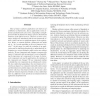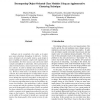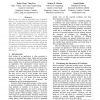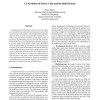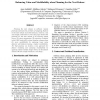103
click to vote
ICSM
2009
IEEE
14 years 10 months ago
2009
IEEE
Most of today's software applications are built on top of libraries or frameworks. Just as applications evolve, libraries and frameworks also evolve. Upgrading is straightfor...
124
click to vote
ICSM
2009
IEEE
14 years 10 months ago
2009
IEEE
Software can be considered a live entity, as it undergoes many alterations throughout its lifecycle. Furthermore, developers do not usually retain a good design in favor of adding...
102
click to vote
ICSM
2009
IEEE
14 years 10 months ago
2009
IEEE
Mailing list repositories contain valuable information about the history of a project. Research is starting to mine this information to support developers and maintainers of longl...
ICSM
2009
IEEE
14 years 10 months ago
2009
IEEE
Field testing of a software application prior to general release is an important and essential quality assurance step. Field testing helps identify unforeseen problems. Extensive ...
134
click to vote
ICSM
2009
IEEE
14 years 10 months ago
2009
IEEE
A build system breathes life into source code, as it configures and directs the construction of a software system from textual source code modules. Surprisingly, build languages a...
110
Voted
ICSM
2009
IEEE
14 years 10 months ago
2009
IEEE
Planning the next release in software release planning addresses the problem of assigning features to the next release such that technical, resource, risk, and budget constraints ...
132
click to vote
ICSM
2009
IEEE
14 years 10 months ago
2009
IEEE
We previously presented a fault localization technique called Value Replacement that repeatedly alters the state of an executing program to locate a faulty statement [9]. The tech...
ICSM
2009
IEEE
14 years 10 months ago
2009
IEEE
109
Voted
ICSM
2009
IEEE
15 years 7 months ago
2009
IEEE
Mainstream IDEs such as Eclipse support developers in managing software projects mainly by offering static views of the source code. Such a static perspective neglects any informa...
143
Voted
ICSM
2009
IEEE
15 years 7 months ago
2009
IEEE
Most of today’s event driven software (EDS) systems are tested using test cases that are carefully constructed as sequences of events; they test the execution of an event in the...
